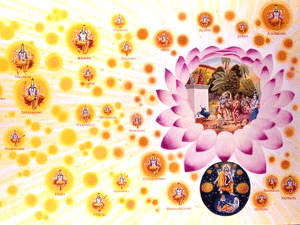Through bhakti that a painting can become beautiful
Ramesvara: For ISKCON Press, there were Jadurani, Bharadwaja came from Montreal, Muralidhara and Devahuti came from LA. Prabhupada said he wanted a painting a day. Try to picture this: you are an artist and you’ve been a devotee for two or maybe three years … or even six months like Bhakta Mark, Muralidhara. You are tasked with painting something that is supposed to exceed the greatest works of art ever known to man. You are supposed to paint something that is more beautiful than Raphael or Da Vinci or Rembrandt has ever painted in their lifetimes because you are painting the beauty, the unlimited, infinitely unlimited beauty of God. So what is the beauty of Mona Lisa compared to God … what is anything compared to that? So these poor artists are shuddering: “How in the world can we accomplish this?”
What Prabhupada is giving the world is so great and our skills and our abilities are so small they don’t match. It is not even close—and then a letter comes and now he wants a painting a day? So, there was a lot of concern, and as they were talking amongst themselves they wrote to Prabhupada that they did not feel adequate or up to this challenge: “We think that our skills as artists are not that great, and we think we need to study seriously and go to an art academy. We need to learn the greatest techniques of the greatest art in the world, and maybe then we will be able to do something that might be slightly worthy of what Prabhupada is going to give to the world. A vision of God: how can we paint that? We barely know even how to paint.”
So Prabhupada explained to them—and this is so extraordinary—he said, “Your whole concept of beauty is mundane. Actually you don’t even know what real beauty is.” Prabhupada started to teach these devotees the definition of beauty. He said, “There are two parts to understanding real beauty.” The first part is that everything in the painting must be authorized and authentic. There can be no imagination, no fabrication, no fanciful imagination like poets and artists of the world who are trying to create something that is beautiful based on what they have seen in the world.”
We have all heard Prabhupada saying that on the Govindam record album. But here Srila Prabhupada said. “No—nothing in the paintings can be inaccurate. It must all be correct and authentic from shastra or from the living Bhagavata. But you cannot know beauty, you don’t even know what beauty is, you have to be told how to present Krishna. For example classic male beauty has muscular forms and so on. Prabhupada had said that this is not beauty. The beauty of a spiritual body is soft and you don’t see the muscular body as it is very soft. Everything has to be authentic; it is not up to the artists to paint what they feel. That was the first definition of beauty that Prabhupada gave them. It is quite different to what they thought beauty was.
The second definition Prabhupada gave them is this: “The only way you are going to achieve beauty is through your heart, through bhakti—devotion to God and not through anything mundane.” Not even through feeling love for the mundane because it is only through bhakti that a painting can become beautiful. “If you don’t paint with bhakti,” he said, “I don’t care what it looks like it will not be accepted”. So this is Srila Prabhupada’s definition of beauty.
